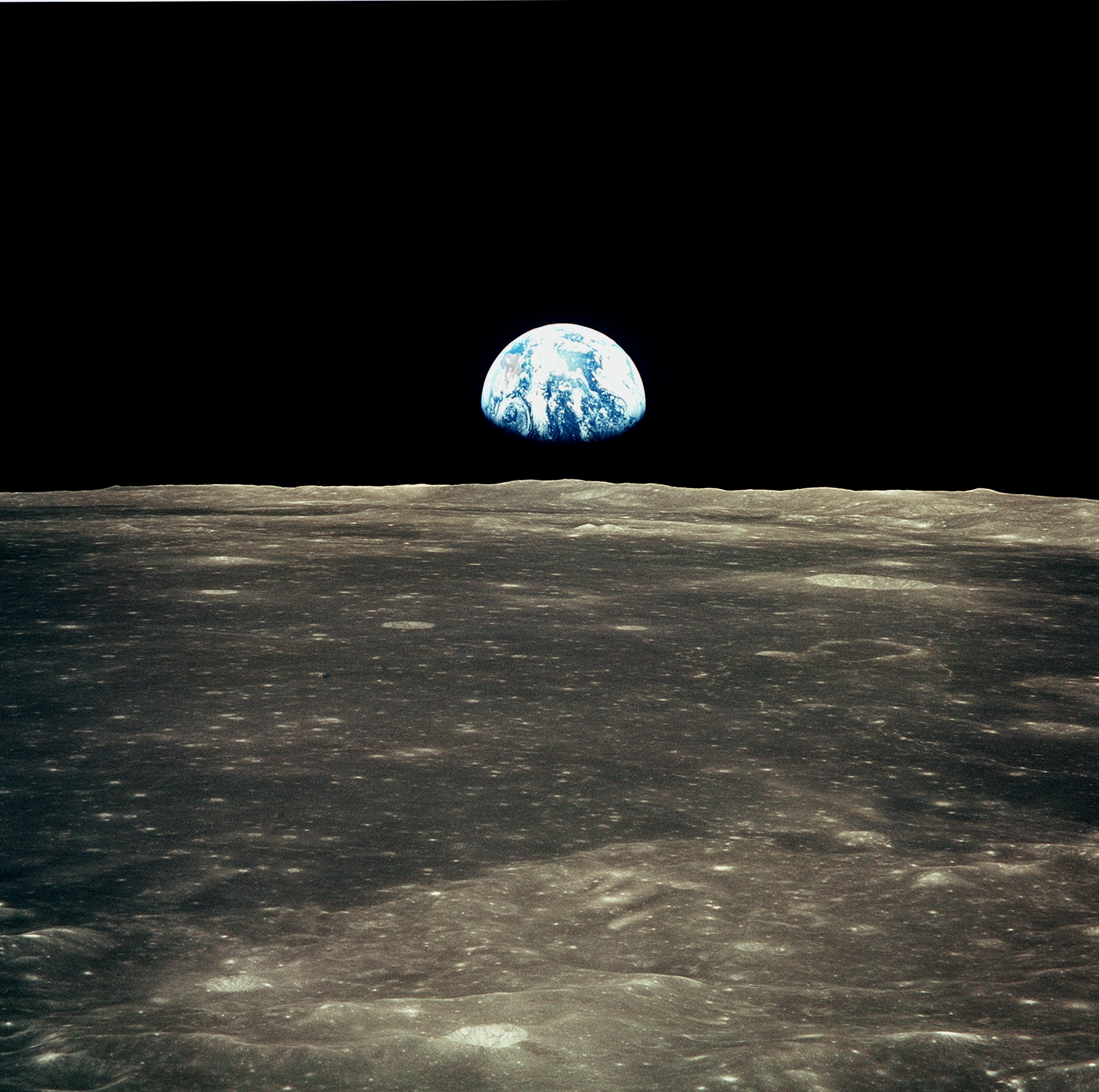
Forty-five years ago, this weekend, on Sunday, 20 July 1969, the Mission Operations Control Room (MOCR) at NASA’s Manned Spacecraft Center (MSC)—later to become the Johnson Space Center (JSC)—in Houston, Texas, was filled with tension and expectant quiet. Gene Kranz, the flight director of the “White Team,” one of four shifts supervising Apollo 11’s voyage to plant the first human bootprints on the Moon, had already order Security to “lock the doors” in anticipation of the momentous events to follow. No one would be permitted to disturb the intense concentration of himself or his control team as they steeled themselves for the most audacious engineering challenge in history. Already, Apollo 11 and its crew of astronauts Neil Armstrong, Mike Collins, and Edwin “Buzz” Aldrin had launched atop the most powerful rocket ever brought to operational status and had traveled across 240,000 miles (370,000 km) of “cislunar space” to reach their mysterious destination. Now, four days after liftoff, their real mission could begin.
When Kranz took the flight director’s seat from colleague Glynn Lunney at 7:00 a.m. CDT, he struggled to hear the hushed voices of the flight controllers. The air was rich with the scent of coffee and tobacco smoke from dozens of ashtrays and the Capcom was nonchalantly reading the morning news to Armstrong, Collins, and Aldrin. A bouquet of roses, sent by some unknown admirer before each mission, stood on a low table by the wall. The center’s deputy director, Chris Kraft, patted Kranz on the shoulder and wished him and his team good luck. Kranz was a man of conservatism and service: An ex-fighter pilot and Korean War veteran, he regarded the space program for what it was—a grand and noble endeavour of scientific discovery—and one of his traditions was to don a white vest, sewn by his wife, Marta. This morning he had walked into the MOCR wearing white brocade with a delicate silver thread. On the flight director’s loop, he told his team that today they were going to land on the Moon. This was their final exam after months of preparation. “And after we finish the son-of-a-gun,” he concluded, “we’re gonna go out and have a beer and say ‘Dammit, we really did something!’”
More than 240,000 miles (370,000 km) away, in low orbit around the Moon, Armstrong and Aldrin undocked their spidery lunar module, Eagle, from the command and service module, Columbia, and began their Powered Descent toward the surface. For the first 26 seconds, as Eagle’s descent engine burned, Armstrong kept it at 10 percent of its rated thrust, producing a gentle acceleration which enabled the computer to gimbal it and ensure that the thrust was directed precisely through the center of mass, before going full-throttle.
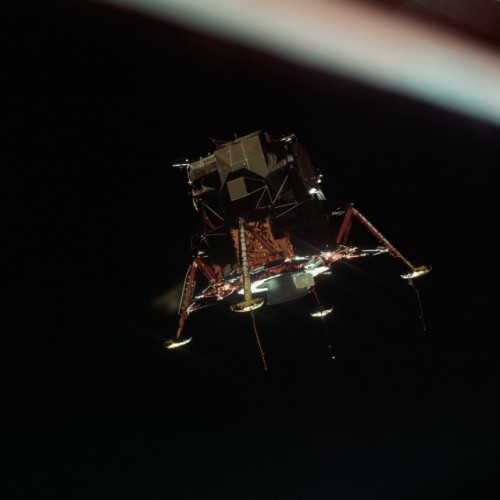
Flying with the engine bell facing the direction of travel and the windows toward the surface, he noticed that they were coming in “long”—they flew over the crater Maskelyne W a few seconds early, for example—and so were likely to overfly their intended landing site. After the flight, it would be judged that very small residual pressures in the tunnel between Eagle and Columbia during undocking had imparted a slight radial velocity that had perturbed their trajectory. (On future flights, approval for undocking would not be granted by Mission Control until the tunnel’s atmosphere had been fully vented.) To Armstrong, however, it really did not matter on the first landing attempt; as he told his biographer, James Hansen in First Man, “I didn’t particularly care where we landed, as long as it was a decent area that wasn’t dangerous.”
Four minutes into the Powered Descent, Eagle rotated “face up” so that the radar on its underside was able to acquire the lunar surface and supply data on altitude and rate-of-descent. “We needed to get the landing radar into the equation pretty soon,” Armstrong told Hansen, “because Earth didn’t know how close we were and we didn’t want to get too close to the lunar surface before we got that radar.” This showed them to be 6.3 miles (10.1 km), somewhat lower than the computer reckoned, because it was tracking their mean height above the surface, rather than their actual height. Aldrin knew that the radar offered the most reliable calculations and planned to instruct the computer to accept that data, but he had to wait for Mission Control to verify it. When they did, he keyed a command to monitor the convergence of the two estimates as Eagle maneuvered. At this point a yellow caution light lit on the instrument panel and an alarm tone sounded.
“Program alarm,” called Armstrong, then glanced down to the computer display and added, “it’s a 1202. Give us a reading on the 1202 program alarm.”
Neither he nor Aldrin had any idea which of the dozens of different alarms the 1202 represented and certainly had no time to flip through their data books to find out. Fortunately, seated in Mission Control was Steve Bales, the guidance officer and an expert on the lunar module’s computer. He checked with Jack Garman, a colleague in the mission support room, and assured Gene Kranz that 1202 was an “Executive Overflow,” meaning the computer was momentarily overloaded, but it would not jeopardise the landing. With typical enthusiasm, Bales yelled into his mouthpiece: “We’re Go on that, Flight!”
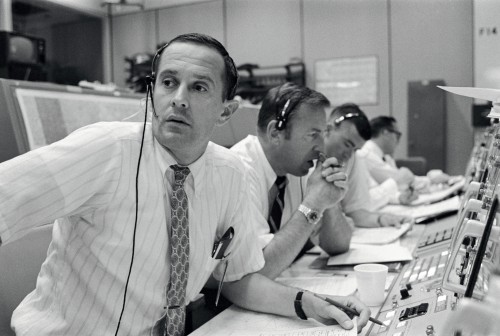
Bales’ call was relayed to Armstrong by Capcom Charlie Duke—“We’re Go on that alarm”—but it was not to be the end of the 1202: It flashed onto Eagle’s display a further three times, but so long as it was only intermittent it did not pose a risk because the computer was able to recover. Three minutes before the scheduled touchdown on the Moon, the computer flashed another alarm: “1201.” This was another form of executive overflow and was quickly cleared, with Duke telling Armstrong and Aldrin “We’re Go … Same type, we’re Go.” For Armstrong, the alarms were little more than an irritation and, as long as everything continued to look fine, he had every intention of pressing on.
However, Buzz Aldrin, in his 1989 autobiography, Men from Earth, stressed that the alarms were a potentially serious obstacle in which “hearts shot up into throats” at Mission Control. Even Steve Bales, who quickly diagnosed the alarms and advised Kranz appropriately, had only become familiar with which of the various alarms mandated an abort, and which did not, a few days earlier.
On the afternoon of 5 July 1969, the Apollo 12 backup landing crew of astronauts Dave Scott and Jim Irwin had been in the lunar module simulator in Houston, running practice descents when a 1201 alarm was thrown at Kranz’s flight control team. From his seat, Steve Bales could only discern that, although everything looked okay with the hardware, there was something amiss with the computer. He advised an abort and Kranz made the call. Scott punched the Abort Stage button and completed a successful return to lunar orbit, but later that evening Bales and Kranz came under fire from the simulation supervisor who had thrown the problem at them. Kranz was criticized on two counts: for ordering an abort when it was not needed (if the guidance system was working, if the thrusters were working, if the descent engine’s performance was good, and if the astronauts’ displays were working, he should have pressed on) and for violating a basic rule of Mission Control, that flight directors had to have two independent cues before calling an abort.
It was a tough, but valuable lesson. By the time Apollo 11 lifted off, Bales had drawn up a list of those program alarms which would make an abort mandatory and those which would not. Neither 1201 nor 1202 were on his list. When the first alarm flashed up, Charlie Duke—who had been sitting at the Capcom’s console during the 5 July simulation—and backroom expert Granville Paules instantly recognized it as “the same one we had in training.” Gene Kranz did not want to be stampeded into an abort now that they were flying the mission for real. On the other hand, if the alarms continued, they could bring Eagle’s computer grinding to a halt and make an abort unavoidable.
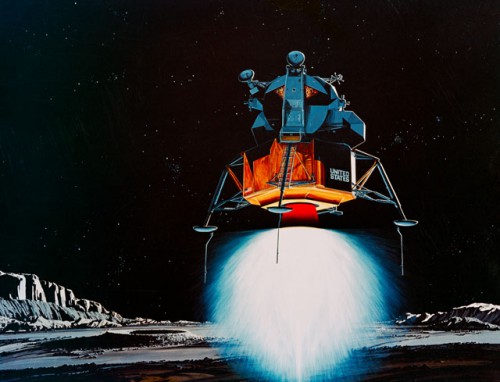
By the time the 1201 alarm appeared, Eagle was already descending below 5,000 feet (1,500 meters) and had performed the “pitch-over” maneuver and was now flying tilted backward, about 20 degrees off-vertical. The astronauts could now “see” the lunar terrain spread out before them. After polling his team, Kranz received a collective “Go for Landing,” a message which Duke now passed on to Armstrong and Aldrin. Yet the furore over the program alarms meant that it was another minute or so, not until a few seconds after 3:15 p.m. CDT, that Armstrong had chance to look at the surface … and behold a particularly nasty sight: the near slope of a vast crater, as big as a football field, its hinterland dotted with boulders the size of small cars. At first, he considered landing “short” of the crater—later dubbed “West Crater”—then picking a spot somewhere amidst the boulders, although the risk of touching down on a slope or in a tight place quickly changed his mind.
At an altitude of around 500 feet (150 meters), a little higher than he had intended, Armstrong selected the semi-automatic mode that would enable him to control attitude and horizontal velocity, while the computer operated the throttle. He pitched Eagle almost upright in order to direct virtually all of its thrust downward and slow the rate of descent, then selected “Attitude Hold” and let Eagle fly a shallow trajectory over the obstacles. As soon as he was clear, he began to seek a suitable location to land.
Drawing closer now, and dropping below 200 feet (60 meters), Armstrong began to discern lunar dust, kicked up by the descent engine, obscuring the surface. The dust, he told James Hansen, was not a “normal” cloud of dust, like those encountered in the high desert on Earth, but effectively a “blanket”—a sheet of moving particulates which essentially wiped out visibility, apart from several boulders poking through it. Moving almost horizontally, the dust “did not billow up at all; it just moved out and away in an almost radial sheet.”
In Mission Control, Kranz’s team knew that Armstrong had intervened early, but they did not yet know why; they could not have known about the yawning crater and the forbidding field of boulders. “The partnership,” between Mission Control and the astronauts, wrote Andrew Chaikin in his 1994 book A Man on the Moon, “had all but dissolved.” In this final phase, everyone on Earth had to understand that Armstrong, the man in command, was now running the mission.
Charlie Duke called to Kranz: “I think we’d better be quiet!”
“Rog,” agreed the flight director. “The only call-outs from now on will be fuel.”
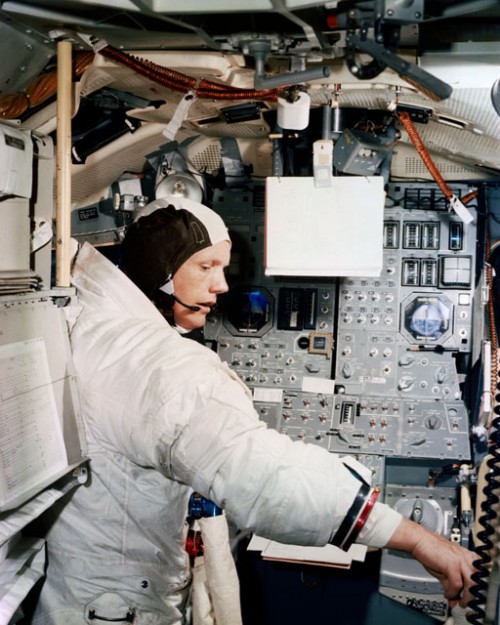
Gradually, it seemed, the situation improved and Armstrong began arresting Eagle’s forward and sideways motion with the thrusters; he intended to land in the first clear spot that he could find. He was virtually silent in those final minutes, the only voice coming from Aldrin, who called out a steady stream of altitudes and velocity components to guide Armstrong—and a tense, listening world—down. “Once I got below 50 feet,” Armstrong told Hansen, “even though we were running out of fuel, I thought we’d be all right. I felt the lander could stand the impact … I didn’t want to drop from that height, but once I got below 50 feet I felt pretty confident we would be all right.”
The fuel was of primary concern, and at 3:16 p.m. CDT Kranz received notification that the “low-level” light had illuminated. Less than 100 feet (30 meters) above the surface, Aldrin reported “Quantity Light,” indicating that only five percent of fuel remained in Eagle’s descent engine. In Mission Control, a 94-second countdown started; when this countdown reached zero, the lander would have only 20 seconds left in which to either touch down on the surface or abort. “I never dreamed,” Kranz recounted years later, “that we would still be flying this close to empty.” Watching the fuel gauge on his display like a hawk, lunar module control officer Bob Carlton reported that only 60 of the 94 seconds remained—an urgent report passed on to Eagle by Charlie Duke—although the astronauts were too preoccupied to respond. “They were too busy,” Kranz said later. “I got the feeling they were going for broke. I had this feeling ever since they took over manual control.” In Mission Control, the silence was so pervasive and so enduring that one could have heard a pin drop. Kranz crossed himself and prayed.
Still, the notion that Armstrong may have been going for broke did not mean that he and Aldrin were being reckless; if they had been still too high when the Quantity Light came on, there would have been no alternative but to abort, but at relatively low altitude it seemed safer and more prudent to press on with the landing attempt. After all, during several of his Lunar Landing Training Vehicle (LLTV) runs above Ellington Field, Texas, Armstrong had successfully touched down with less than 15 seconds of fuel in his tanks, so he was not particularly “panic-stricken” about the low levels.
At 3:17:26 p.m. CDT, Aldrin called out that they were barely 20 feet above the surface and, 13 seconds later, announced “Contact Light” as one of the sensor prongs projecting below Eagle’s footpads touched alien soil. Armstrong would later tell Hansen that he did not react instantaneously when the light glowed blue, thinking it to have been an anomaly and not entirely certain, thanks to the dust, that they had really touched down. As a result, he was a second or two late in shutting down the engine. Forty seconds had now passed since Charlie Duke’s last call, yet post-mission analysis would reveal that—due to propellant sloshing around in the descent stage tanks and giving inaccurate readings—Eagle actually had around 45 seconds of fuel remaining. …
“Shutdown!” called Armstrong, punching the Engine Stop button. Meanwhile, Aldrin began reciting each step of his post-landing checklist and they jointly took the requisite actions to shut down now-unneeded systems—“ACA out of detent, Mode controls: both auto, Descent engine command override: off, Engine arm: off.” Lastly, Aldrin added, “413 is in,” which told Eagle’s Abort Guidance System to remember the attitude of the vehicle on the surface.
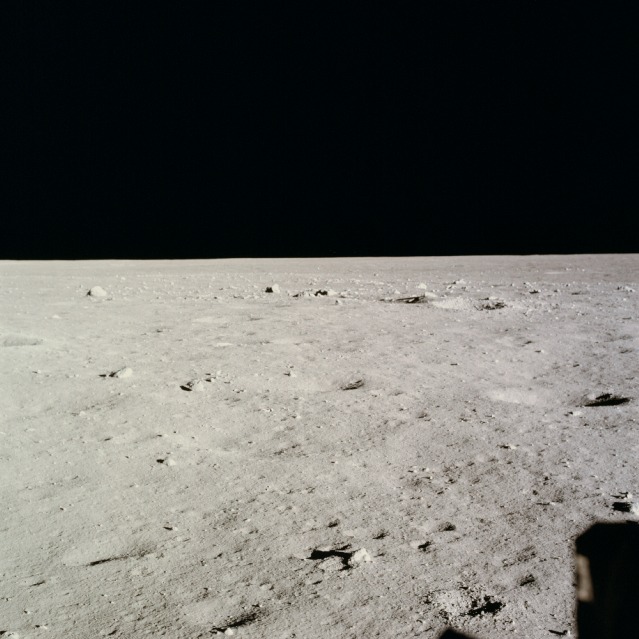
Outside, the dust which had lain undisturbed for a billion years or more began to settle. The altimeter ceased flickering and the surface shuddered, then fell still. They had set down on a broad, roughly level plain. It was later determined that Armstrong landed about 4 miles (6 km) downrange of their intended spot, at co-ordinates 0.67409 degrees North by 23.47298 degrees East. The color of the surface seemed to be a mixture of ashen greys, tans, and browns and brightened into an intense, chalky white. Some nearby rocks seemed fractured or disturbed by the descent engine; Armstrong thought they looked like basalt. The surreal stillness of the scene and the silence of ages surrounded them. Inside their bulky space suits and bubble helmets, their mouths bone-dry from ingesting pure oxygen for so long, both men were breathing hard; yet they took a few seconds to grin at each other, before Armstrong keyed his mike.
“Houston,” he radioed, in perhaps the most electrifying statement of the 20th century, “Tranquility Base here. The Eagle has landed!”
Charlie Duke’s response was entirely appropriate for his personality, defusing with humor the enormity of what had just happened. “Roger, Tranquility, we copy you on the ground. You’ve got a bunch of guys about to turn blue! We’re breathing again. Thanks a lot.” Prior to launch Armstrong had told Duke and Aldrin that he intended to change Eagle’s radio callsign to “Tranquility Base” whilst on the Moon, but it came as something of a surprise to those who did not know. Aldrin did not expect him to use it so soon after landing and even Duke seemed tongue-tied when he tried to pronounce it in those euphoric first seconds.
In Mission Control, “euphoria” was an understatement. “The whole [room] was pandemonium,” wrote Deke Slayton in his autobiography, Deke, co-authored with Michael Cassutt. “It took about 15 seconds to calm down.” Around the world, the feeling was the same. Walter Cronkite was uncharacteristically speechless. Seated in the CBS studio next to former astronaut Wally Schirra, he stumbled over his words as he stammered to his audience: “Boy … Man on the Moon!” To paraphrase the Nobel Prize-winning physicist Robert Hofstadter, the first landing on the Moon may well be the only occurrence from the 20th century to be remembered clearly a thousand years from now.
In Houston, the lighting of cigars, the waving of flags, the slapping of backs, and the free-flowing of tears which only Americans could produce in such copious quantities would go on long into the night. John Houbolt—the NASA engineer who advocated lunar-orbital rendezvous for Apollo—recalled Wernher von Braun turning to him, shaking his hand and saying warmly “Thank you, John.” For Houbolt, being so honored by the man who created the Saturn V, it was one of the greatest compliments of his life.
Another compliment was paid to someone else that evening. For more than five years, John F. Kennedy, the president who committed America to landing a man on the Moon before the decade was out, had lain in his grave at Arlington National Cemetery. On the hot midsummer’s evening of 20 July 1969, amid all the excitement and celebration, an anonymous someone placed a small bouquet of flowers onto his grave.
The card bore a poignant inscription.
“Mr President,” it read, “the Eagle has landed.”
Tomorrow’s article will focus on humanity’s historic first steps on the Moon.
Want to keep up-to-date with all things space? Be sure to “Like” AmericaSpace on Facebook and follow us on Twitter: @AmericaSpace




I’ve heard the story of the flowers and card left at the JFK grave site before; does anyone know if that card was preserved anywhere? Doesn’t Arlington collect and archive things left at the graveside like is done with the Vietnam Memorial? I would really like to know if this card still exists.